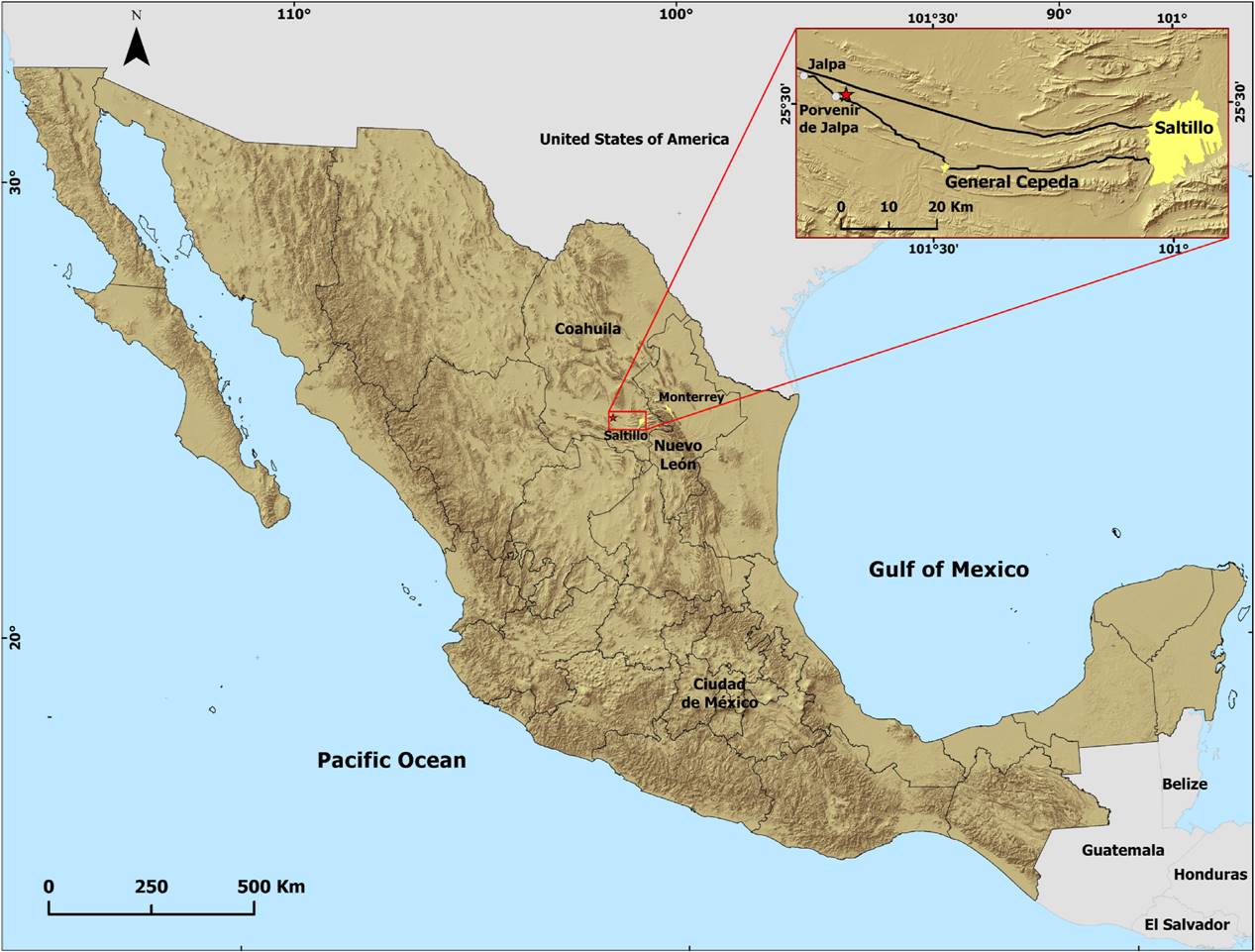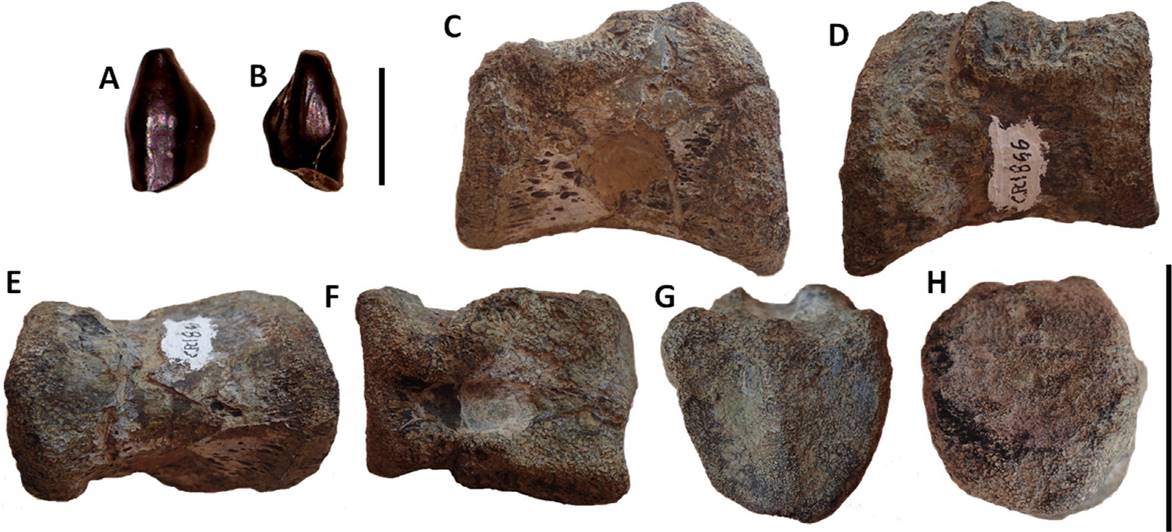1. Introduction
Parksosauridae are a little understood family of small ornithischian dinosaurs, with a controversial phylogenetic relationship within Ornithopoda (Bucholtz, 2002; Boyd, 2015). As its skull and dentition appear to be primitive within Ornithopoda, much resembling hypsilophodontids (Galton, 1974a; Boyd, 2014), the family it has been grouped either as “hypsilophodontid” (Sereno, 1998), a member of the Thescelosauridae (e.g.Galton, 1973; Butler and Galton, 2008), or equivalent to that family (Boyd, 2015).
Parksosauridae are small-bodied, bipedal, cursorial, lightly-built dinosaurs, which are known from the Aptian to Maastrichtian of North America and Asia (Norman et al., 2004; Boyd et al., 2009). The skull is proportionally small with respect to the body, it is elongate with flat frontals and has lingually curved and labiolingually compressed leaf-shaped teeth (Galton, 1997). The enamel of the teeth crowns is crenulated and lacks serration.
Parksosauridae is documented from Canada and the United States, while it was hitherto unknown in México. Here we describe the fossil remains to a basal ornithopod remains found during the spring of 2014, 4.2 km east of the Las Águilas locality, east of the hamlet Porvenir de Jalpa, and about 50 km west of Saltillo, Coahuila, north-eastern México, in rocks of the Cerro del Pueblo Formation (Figure 1).

Figure 1. Geographic location of the Porvernir de Jalpa, Las Águilas fossil site in Coahuila, north-east México.
Institutional Abbreviations: CPC- Colección Paleontológica de Coahuila, Saltillo, Coahuila, México; CNA- Consejo Nacional de Arqueología, México; IEUH- Institute of Earth Sciences, Heidelberg University, Germany; INAH- Instituto Nacional de Antropología e Historia; MUDE- Museo del Desierto, Saltillo, Coahuila, México; SMNK- State Museum of Natural History, Karlsruhe, Germany; SGM- Servicio Geológico Mexicano, Pachuca, México.
2. Materials and Methods
The geology, stratigraphy, and paleoecology of the Las Águilas section have recently been presented by Vogt et al. (2016) and Rivera-Sylva et al. (2017). The locality with remains of Parksosauridae, with the field number “Las Águilas 14” (LA 14), is a new site located about 1.5 km west of Cerro de Angostura. At LA 14, abundant surface material has weathered out of a fine-grained, green-to buff-colored siltstone.
The fossils documented here at LA14 were collected during an extensive surface survey in 2014 by a joint team from MUDE, SMNK, IEUH, and SGM. They are housed and cataloged at the Museo del Desierto (MUDE). Locality information is on file at that institution. The specimens were photographed using an Olympus E 620 with an Olympus Zuiko standard lens (14 - 42 mm, f/3.5 - 5.6), an Olympus Zuiko macro lens (35 mm, f/3.5); and a Canon EOS Rebel T2i with a Canon lens 18 - 55mm, 1:3.5 - 5.6 IS II.
The specimens reported here were collected with permission of the INAH through its Consejo Nacional de Arqueología [CNA; Oficio 401.B(4)19.2013/36/1862].
3. Systematic paleontology
Ornithischia Seeley, 1888
Cerapoda Sereno, 1986
Parksosauridae Bucholtz, 2002
Parksosauridae indet.
Referred specimens - CPC 1872 (Figure 2, A-B), a right premaxillary tooth; CPC 1866 (Figure 2, C-H), a posterior sacral vertebral centrum.

Figure 2. Parksosauridae fossils from the Cerro del Pueblo Formation. A right premaxillary tooth (CPC 1872) in: (A) labial view and, (B) lingual view. Fifth sacral vertebra (CPC 1866) in: (C) left lateral view; (D) right lateral view; (E) ventral view; (F) dorsal view; (G) cranial view; (H) caudal view. Scale in A-B: 5 mm; C-H: 5 cm.
Locality - LA 14 near Las Águilas, Porvenir de Jalpa, Coahuila, northeast México (Figure 1).
Description - CPC 1872 (Figure 2, A-B) consists of a premaxillary tooth crown, slightly labiolingually compressed and slightly constricted at its base. Apically to this constriction, the crown is asymmetrically bulged. The bulge is twice as pronounced distally compared to mesially, and only misses the labial face of the crown. The tip of the crown is blunt. The tooth crown is slightly curved lingually and bears a small wear facet on its tip, showing a few coarse labial striations, which display a high degree of wear. The absence of the root suggests a shed tooth (Frey and Monninger, 2010). The crown height is 5 mm, with a basal maximum diameter of 3 mm.
CPC 1866 (Figure 2, C-H) is a posterior sacral vertebral centrum, interpreted as the fifth sacral, which is shallowly amphicoelous and constricted around its middle. The bone is 1.5 times longer and slightly higher than wide. In anterior and posterior views, the centrum is rounded triangular in cranial outline and has a concave area separated by a dorso-medial ridge, with a flat dorsal margin and slightly convex lateral margins. The dorsal surface is ornamented with deep transverse striae that accommodate the peduncles of the neural arch. The floor of the neural canal is hourglass shaped in dorsal aspect. It is 48 mm long, 42 mm deep and 31 mm wide.
4. Discussion
The shape of the premaxillary tooth face, including the blunt tip, the striations on the lingual side, the smooth lingual surface, the constricted base, and the lingually curving blunt crown, are seen in Thescelosaurus and Hypsilophodon (Galton, 1974b; Boyd, 2014). In Parksosaurus, the premaxilla is missing (Parks, 1926; Sternberg, 1940), thus differing from other ornithischians with leaf-shape teeth (i.e., pachycephalosaurids). Serrations are absent on both the anterior and posterior margins, which also is the case in neoornithischians Changchunsaurus, Haya, and Jeholosaurus (Barrett and Han, 2009; Jin et al., 2010; Makovicky et al., 2011).
The sacral vertebrae of Parksosaurus, Thescelosaurus, and Dysalotosaurus are very similar to those reported for Hypsilophodon (Galton, 1974b). The constricted centrum across their middle circumferrence and the shallow platycoelous intervertebral joints are features seen only in this group (Gilmore, 1915; Brown et al., 2013). The widened centrum, in cranial view, towards the caudal face, and ventrally longitudinally concavity, identifies this vertebra as the posterior-most sacral element of the series (sa. 5) (Galton, 1974b) it much resembles vertebrae illustrated by Carr and Seitz (2015; p. 107) for Thescelosaurus, and Galton (1974b) for Hypsilophodon. The neural arch is not preserved and may have fallen off during diagenesis. The striae on the centropeduncular articulation indicate that the neurocentral suture must have been open, which is suggestive for an immature individual (Brochu, 1996; Irmis, 2007), contrasting with the vertebrae of adult pachycephalosaurids, which show strong sutural fusion (Gilmore, 1924; Sues and Galton, 1987).
The only well-known basal cerapoda taxon from the late Campanian of North America, Orodromeus, occurs in the Two Medicine Formation (Montana). These osteological remains resemble an unnamed basal ornithopod from the Kaiparowits Formation Utah; Gates et al., 2013.











 nueva página del texto (beta)
nueva página del texto (beta)


